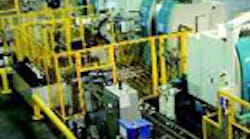Machine tools packing factory automation are on the shop floor in days not years.
By Charles Bates
senior editor
Doosan turning cells come from the factory fully automated, which allows manufacturers like Systrand to slash months of installation time from their productivity schedules.
For instant automation, Doosan machines include control interfaces that connect to a robot's PC controller for smooth, rapid operation.
Systrand's Tony Kuczek (left) and Michael Cannarsa examine an automotive differential case for a job won, in part, because of automationready machining cells from Doosan.
An inspector at Systrand checks critical part dimensions. For automated production-line quality control, the shop's Doosan vertical turning centers sport factory-equipped interfaces for inprocess gaging.
Whether or not a shop wins a job-contract bid often boils down to how fast a shop can integrate automation on its factory floor. Unfortunately, getting an automated machine tool can take up to a year and include another six months of setup time before it is productive. One machine tool OEM, however, is speeding the process with its "drop-and-run" automated cells.
Quick Loading (QL) series, two-spindle horizontal turning cells from Doosan Machinery America Inc., Sterling Heights, Mich., leave the factory fully equipped and automated. Their modular designs and built-in interfaces let Doosan quickly add part stackers, robot gantry loaders, and post-process gaging.
The builder is delivering QLs to its U.S. customers in about 120 days. This is great news for end users like Systrand Manufacturing Corp. in Brownstown, Mich.
The tier-one automotive supplier and long-time Doosan customer recently bid on a contract to produce a quarter-million differential cases yearly for Chrysler's Jeep series. The project's aggressive launch schedule called for Systrand to go from drawing to part production in only 26 weeks.
Working with application engineers at Doosan, Systrand's team fine-tuned project parameters and decided on appropriate machines and automation for a turnkey system. They chose four Doosan V420T twin-spindle vertical lathes with three factory-integrated Yaskawa Motoman robots for parts handling and Fanuc 18iTB controls to oversee OP20 and OP30 machining cycles.
The V420T lathes sport 12-in. chucks, 22.4-in. swing-over beds, and 25/30-hp (2,500-rpm) spindles. Generating 485 ft-lb of torque, the spindles make easy work of the 81/4-in. cast-iron differential cases.
According to Young Park, president of Doosan America, the company's vertical lathes, with swings up to 40 in., are also easily automated.
They readily accept integrated robots that load/unload parts but also rotate and transfer these parts from the machine's first spindle to its second. And machine controls interface with a robot's PC controller for smooth, rapid operation.
Besides the Doosan cells, Systrand's line includes turning and horizontal machining centers from Mori Seiki, turning centers from Hwacheon, a parts washer from Milbrook, and a palletized conveyor for material removal.
Doosan ensured its part of the line met Systrand's requirements by erecting it on its own factory floor in its Korea plant. "With this setup, we machined the part and proved out the system before installing it in our Michigan plant," explains Tony Kuczek, vice president of engineering at Systrand.
The system, with integrated automation and gaging, holds critical part tolerances and meets Systrand's 2.0-CpK requirement. Several inspection stations within the line maintain differential case quality and allow for continuous-improvement and preventative-maintenance procedures.
In comparing Doosan's automatedcell-concept to conventional transfer lines, Kuczek says that transfer lines are not as capable of producing and maintaining the tight tolerances for controlling backlash and meeting automotive noise-level requirements.
| AUTOMATION EXTRAS Using automation-ready equipment is only part of Systrand's plan for successful automated production. The company also focuses on tooling and training. For instance, the manufacturer makes most of its own tooling for the automated cells. According to Michael Cannarsa, executive director of operations at Systrand, cost, quality assurance, and timing are the three reasons why. The company has the equipment and skills to build inhouse tooling at a cost lower than farming out the work. Building inhouse also ensures available tooling levels keep up with automated equipment and production. Finally, it lets Systrand control quality and tooling flow. The company uses carbide tooling in the 12-station toolchangers attending to each spindle on the Doosan automated vertical lathes. A tool-lifemanagement program alerts operators for toolchanging at a set parts/tool number according to the demands of either roughing or finishing. To maintain a schedule, all tools in a particular group are changed. "We are constantly fine-tuning the system," says Kuczek, "to drive down the cost of tooling and toolchange frequency. This is extremely important in an automated system for keeping it as productive as possible." When Systrand starts a new job, such as on the automated differential case line, company trainers run the job first and optimize the operations. These trainers then transfer job information gained in the launch phase to those that will run the system on a daily basis. All training is bilingual, and the company uses computerized training classrooms as well as onthe-floor training sessions. A staff of 12 runs the training department. |










